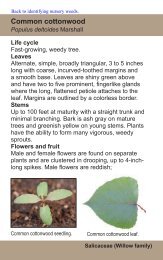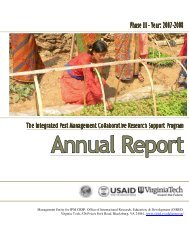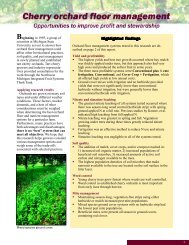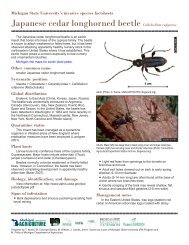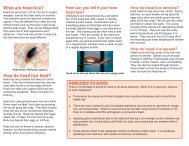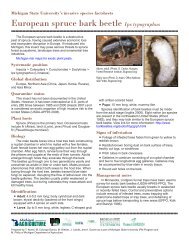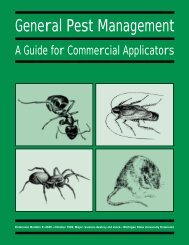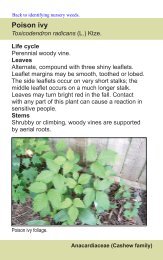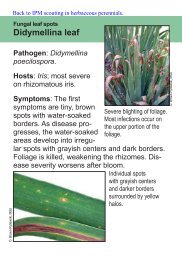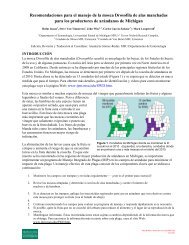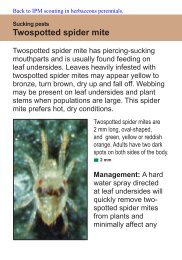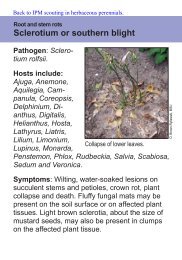Whole Manual - Michigan State University: Integrated Pest ...
Whole Manual - Michigan State University: Integrated Pest ...
Whole Manual - Michigan State University: Integrated Pest ...
You also want an ePaper? Increase the reach of your titles
YUMPU automatically turns print PDFs into web optimized ePapers that Google loves.
educed yields. They feed on a wide variety of plants,<br />
including alfalfa, and can rapidly move from crop to<br />
crop. They may migrate into snap beans after the cutting<br />
of nearby alfalfa.<br />
Control strategies:<br />
■ Begin scouting fields using a sweep net when plants are<br />
in bloom and continue through small pod development.<br />
■ With their wide host range (dozens of crops and<br />
weeds), there are no practical non-chemical control<br />
options at this time.<br />
■ Insecticide applications for potato leafhoppers also<br />
reduce tarnished plant bug populations, which move<br />
about freely, resuming feeding soon after an application.<br />
EUROPEAN CORN BORER (Ostrinia nubilalis)<br />
The European corn borer is a pest of snap beans.<br />
European corn borers overwinter as full-grown larvae in<br />
corn debris, usually field corn. Beginning in mid-June,<br />
the first generation of adult moths emerge and mate in<br />
tall grasses. The adult moths are cream to light brown.<br />
The female moth lays her eggs, which look like fish<br />
scales, on the undersides of corn leaves. The larvae hatch<br />
and feed on the leaf, eventually moving into and feeding<br />
down in the whorl. As the larvae mature, they enter the<br />
stalk to feed and pupate. After second-generation<br />
European corn borers adults mate, the females deposit<br />
eggs on the leaves in the ear zone of silking corn. The larvae<br />
feed on the developing ears, causing kernel damage,<br />
or enter the stalk, ear shank or cob. Depending on the<br />
temperature, there are two or three generations of<br />
European corn borer per year.<br />
Damage: Young larvae feed on leaves, buds and flowers;<br />
mature larvae burrow into stems and beans. The greatest<br />
risk of European corn borer contamination is from bud to<br />
pin bean stage. Eggs laid 14 days or less before harvest<br />
will generally not result in damage or contamination. A<br />
very small proportion of European corn borer eggs survive<br />
long enough to lead to pod damage, but the tolerance<br />
for injury for processing is zero, and management is<br />
required.<br />
Control strategies:<br />
Non-chemical—A number of factors affect European<br />
corn borer populations but they are out of your control. A<br />
series of cool evenings (below 65 degrees F), or a heavy<br />
rain can reduce the number of eggs laid or the survival of<br />
small larvae. In addition, young larvae can dehydrate<br />
and blow away on hot, windy days. Thus, conditions present<br />
during European corn borer mating, egg laying, and<br />
development of eggs and small larvae are critical in<br />
determining the population from year to year.<br />
Biological—A large number of natural enemies attack all<br />
life stages of European corn borer. Generalist predators<br />
such as lady beetle larvae and adults, lacewing larvae, and<br />
minute pirate bugs feed on egg masses and small larvae.<br />
Other insects and birds eat large larvae and pupae. In locations<br />
with large populations of predators, their role in controlling<br />
European corn borer should be taken into consideration<br />
when determining a management strategy.<br />
Though parasitoids have been imported from Europe<br />
to control European corn borer, only a few have been successfully<br />
established. The amount of control from these<br />
parasitoids varies from year to year and depends on the<br />
location and shape of each field.<br />
Two main pathogens affect European corn borer populations.<br />
Beauvaria bassiana is a naturally occurring fungus<br />
that usually kills overwintering larvae; dead larvae<br />
look white and furry. Most epidemics of B. bassiana occur<br />
late in the season during and after periods of rainfall<br />
when temperatures are in the mid-80’s F. Nosema pyrausta<br />
is a protozoan-like microbe that reduces European corn<br />
borer egg laying, kills some larvae, and increases overwintering<br />
mortality.<br />
Chemical—Timing is critical for a successful pesticide<br />
application. Larvae will be controlled only when they are<br />
moving on the plant and NOT after they are feeding<br />
inside the pods or stems. The treatment window for<br />
European corn borers is from bud stage to 14 days before<br />
harvest. Preventive insecticide applications are recommended<br />
for processing snap beans during this period.<br />
INSECT PESTS OF TOMATOES<br />
COLORADO POTATO BEETLE<br />
(Leptinotarsa decemlineata)<br />
Colorado potato beetles feed on plants in the family<br />
Solanaceae, which includes potato, tomato, eggplant,<br />
nightshade, and horsenettle. For detailed information on<br />
their life cycle, see the section on potatoes.<br />
Damage: Colorado potato beetle adults and larvae feed<br />
on tomato foliage and fruit. Though they prefer to feed<br />
on potatoes, they can easily defoliate an entire tomato<br />
plant in three to four days.<br />
Control sÏtrategies:<br />
■ Crop rotation helps delay and reduce spring infestations.<br />
■ Trap crops of potatoes planted along field edges<br />
attract migrating Colorado potato beetle adults and<br />
delay tomato infestation for a few days.<br />
■ Several natural enemies aid in controlling the<br />
Colorado potato beetle, though they seldom provide<br />
sufficient larval or adult control.<br />
■ Foliar insecticides can be applied to trap crops or “hot<br />
spots,” small isolated areas of infestation, to avoid<br />
treating an entire field. Insecticides are most effective<br />
on small larvae.<br />
TOMATO HORNWORM<br />
(Manduca quinquemaculata)<br />
Tomato hornworms can quickly defoliate plants<br />
because the larvae are large (up to four inches long).<br />
Larvae are pale green caterpillars with white markings<br />
and a horn at the rear end. In May or June, tomato hornworms<br />
emerge from their overwintering sites as adult<br />
Chapter 5<br />
46<br />
Vegetable Crop <strong>Pest</strong> Management



